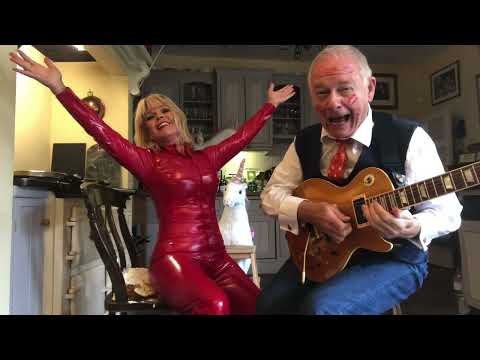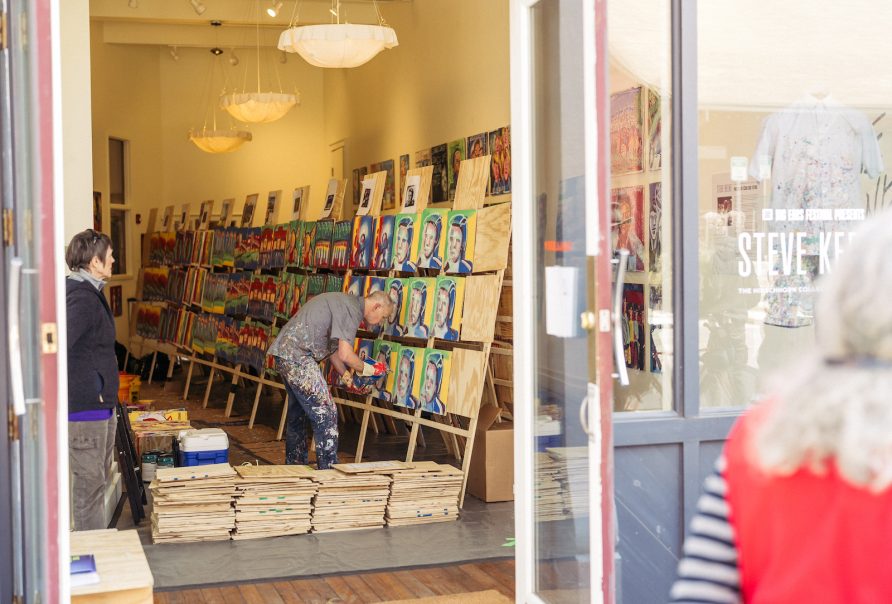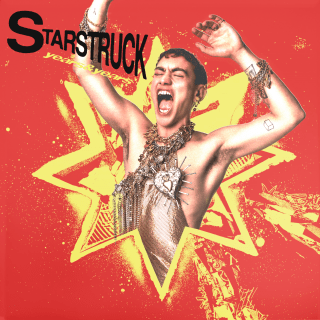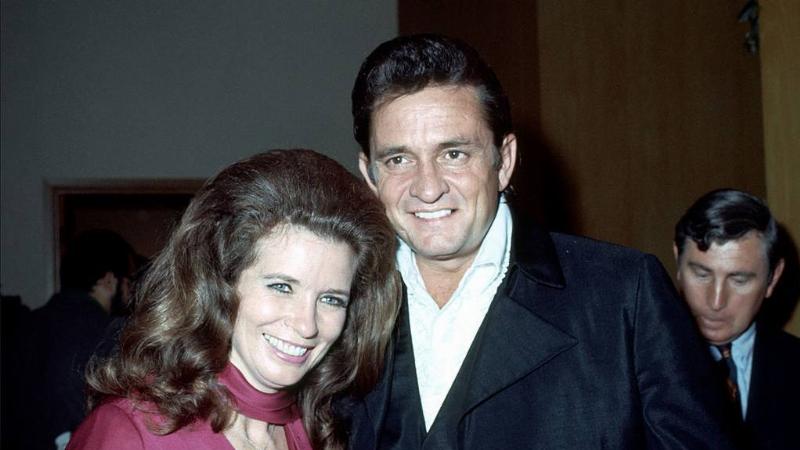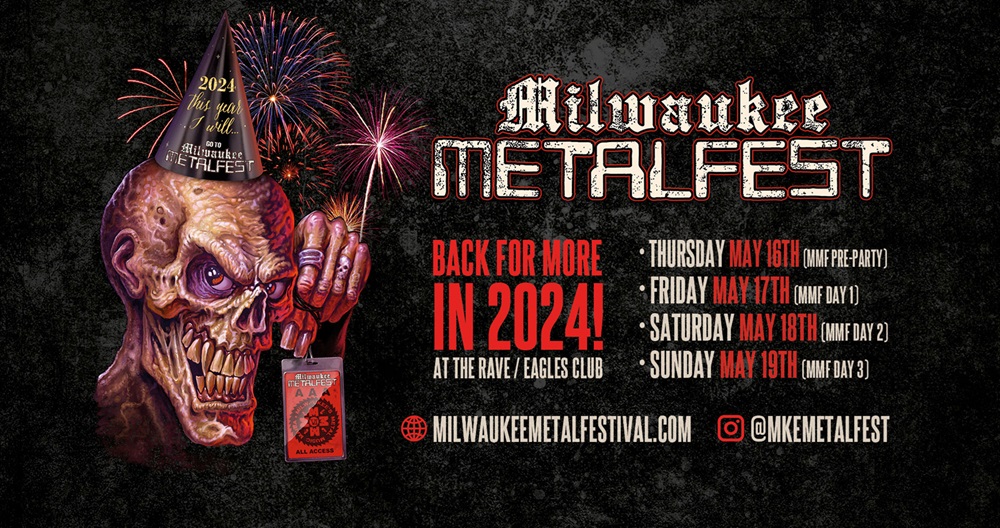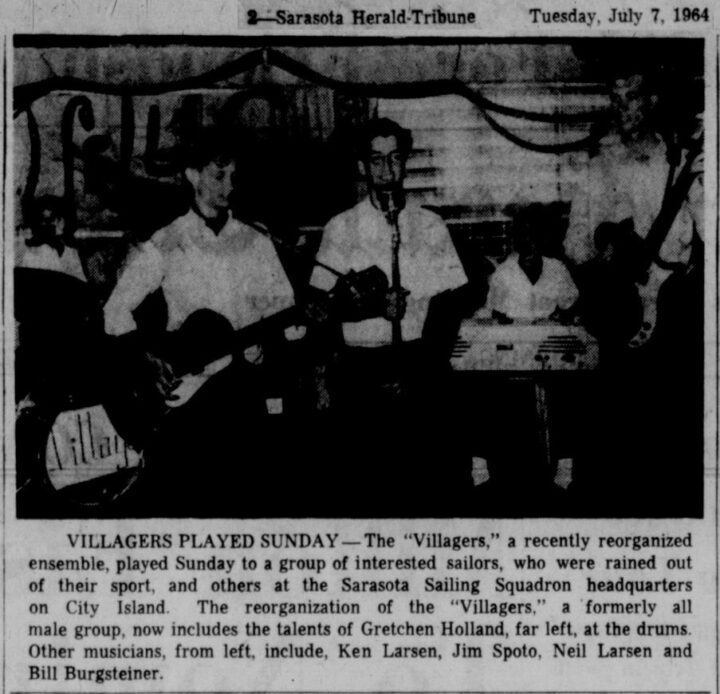Indie Basement is a weekly column on BrooklynVegan focusing on classic indie and alternative artists, “college rock,” and new and current acts who follow a similar path. There are reviews of new albums, reissues, box sets, books and sometimes movies and television shows. I’ve rounded up February’s best music, highlighting my favorite songs and albums, plus links to relevant features and news, a monthly playlist, and more.
The shortest month of the year was just a little longer than usual, 2024’s a leap year, and it felt just a little extra too as far as all the great music that came out in February. I picked 10 of my favorite songs to write about, including a couple veterans who haven’t released new music in over 10 years, new artists just starting out, and some great janglepop.
As far as February albums, I picked five this month but runner ups include MGMT’s Loss of Life, Grandaddy’s Blu Wav, OMNI’s Souvenir, Stereolab singer/guitarist Laetitia Sadier’s Rooting for Love, Chelsea Wolfe’s She Reaches Out To She Reaches Out To She, and Britpop vets Cast’s Love is the Call.
In addition to the reviews I made a playlist featuring all 10 Songs of the Month, tracks from my Albums of the Month (and runner-ups), plus everything else I liked in February. Listen to that (Spotify or TIDAL) and check out the rest of the Indie Basement February roundup below…
INDIE BASEMENT – BEST SONGS OF FEBRUARY 2024
Beth Gibbons – “Floating on a Moment”
Eleven years after signing a solo deal with Domino, Portishead’s Beth Gibbons is finally releasing an album. Worth the wait? Of course. Beth’s voice is as spine-tingling as ever, and the production is cinematic and surprising — who would’ve expected a children’s chorus? That’s a tricky high-wire move that Beth nimbly pulls off. (Too bad about the AI video, though.) When the harpsichord-flecked chorus kicks in, we are all floating.
—
Cast – “The Rain That Falls”
Led by former La’s bassist John Power, Britpop vets Cast released their seventh album, Love is the Call, earlier this month and it’s the best thing they’ve done since their 1995 debut, All Change. It’s also their biggest hit since All Change, having debuted on the UK album charts in the Top 20. The whole thing’s terrific but “The Rain That Falls” is the standout, a signature slice of Cast power-pop that’s loaded with ringing guitars and wonderful harmonies on the perfect earworm chorus.
—
Clothing – “Kingdom” (ft Amber Coffman)
Aakaash Israni (Dawn of Midi) and Ben Sterling (Cookies, Mobius Band) have been friends for over a decade but only recently started making music together in earnest. “Kingdom” is their debut single as Clothing and it features sultry vocals from onetime Dirty Projectors vocalist Amber Coffman. At first this sounds like it’s going to be cookie-cutter nu-R&B but then the beats and synths kick in and “Kingdom” takes off into intoxicating realms. There’s a great little moment where Amber’s “oooohs” drop and fade with the synths as if they’ve fallen into a bottomless pit, before bouncing back out. A great debut that sets a high standard for whatever’s next.
—
Dent May & Jordana – “Coasting on Fumes”
Dent May really has a way with twisting a familiar phrase into new territory, especially when applied to romantic entanglements. (I’m a big fan of his 2017 single “Face Down in the Gutter of Your Love“) “Coasting on Fumes” makes the most of car metaphors — “heading nowhere fast / dangerously low on gas” — with help from fellow indiepop artist Jordana for this sweet piece of “love the one you’re with” janglepop that floats along a lightly melancholic breeze.
—
En Attendant Ana – “Magical Lies”
One of my favorite bands of the last 10 years, Paris’ En Attendant Ana just keep getting better. Few bands have this much winsome charm backed up by serious chops and muscle. Their third album, Principia, was among my favorites of 2023 and they’ve already back with a 7″ via the Sub Pop Singles Club featuring two newly recorded songs (and not leftovers from the Principia sessions). “Magical Lies” is all jazzy chords and sunny horns but then in comes a hypnotic bassline that makes for an imagined team-up between The Cardigans and Stereolab.
—
Four Tet – “Daydream Repeat”
What I like about Four Tet is that Keiran Hebben has aged so gracefully. Some of his contemporaries try to keep up with the kids, but he just does his own thing — even when it occasionally involves Fred again.. or Skrillex — and still makes it feel fresh. The perfectly titled “Daydream Repeat” sprinkles a minimal disco beat with a gossamer harp pattern that makes you wonder what he might do with a new staging of Swan Lake.
—
Ibibio Sound Machine – “Got to Be Who U Are”
After working with Hot Chip on last year’s Electricity, London dance collective Ibibio Sound Machine collaborated with Ross Orton (Arctic Monkeys, M.I.A.) for their upcoming Pull the Rope. They say they’ve switched venues “from the sunny buoyancy of a sunlit festival to a sweat-soaked, all-night dance club.” There’s still plenty of light in “Got to Be Who U Are,” but it’s also a banger that plays like a mash-up of 1991, with house-style vocals atop backing that could be acid jazz if it left the jazz at home.
—
Les Savy Fav – “Legendary Tippers”
I did not have “New Les Savy Fav Album” on my 2024 bingo card, don’t know about you, but I’m glad these guys are back. While they’ve played the the occasional show, this is is their first new music since 2010. They are all now well into their 40s but “Legendary Tippers” still sounds like a wild Williamsburg party, though like their old neighborhood, things have gone slightly upscale: “Our backstage passes come with opera glasses / We’ve got caviar in our mini bar.” Tim Harrington remains shirtless, though.
—
METZ – “Entwined (Street Light Buzz)”
SHRRRRRING! This first single from Toronto band METZ’ first album in four years starts like a lot of their songs do, with a mutant, melty guitar riff. You brace yourself for what comes next, and while things do get loud — this is METZ, after all — they’ve also discovered discovered the joy of hooks and melody. “Entwined” is easily the catchiest METZ song ever and their use of dynamics here, along with the singalong chorus, just make the loud bits hit harder.
—
Warpaint – “Common Blue”
Warpaint have always been chill, but they attain new levels of relaxed vibes on this excellent new single that finds them back on Rough Trade after one album on Virgin. (it’s also a celebration of their 20th anniversary as a band.) You could almost imagine this as one of the groovier Feist songs on Let It Die, but it’s also still totally a Warpaint song with their undeniable mild-meld chemistry sending this one off into the sunset.
—
INDIE BASEMENT – BEST ALBUMS OF FEBRUARY 2024

IDLES – TANGK (Partisan)
TANGK‘s mix of melody, menace and heart that is the key to the album, which may win over people — like myself — who didn’t take to IDLES’ output through 2020’s Ultra Mono. Call it “Resistance as an Act of Joy,” this is their most accessible collection of songs to date, still with lots of bruising energy but also overflowing with heartfelt lyrics. The combo really works, and it’s probably no accident the album came out the same week as Valentine’s Day. IDLES hinted at this direction on 2021’s CRAWLER, a real chrysalis of album, but they emerge as a fully formed butterfly on TANGK. A Muhammed Ali type butterfly, mind you, that can still sting like a bee. [Full Review]
TANGK by IDLES
—

Mary Timony – Untame the Tiger (Merge)
While Mary Timony has stayed musically busy since the late-’00s with Wild Flag and Ex Hex (and as a guitar teacher for the likes of Snail Mail’s Lindsey Jordan and other DC-area residents), new album Untame the Tiger is her first record under her own name in nearly two decades. This is a pandemic work and Mary had an especially rough last four years, losing both parents (and being their sole caregiver), and going through a bad romantic breakup. There’s a lot of well-traveled insight here, leavened just enough by well-placed dashes of cutting humor. Great music too. Mary is a skilled musician with a love of British folk and prog that can really be felt this time; Fairport Convention / Steeleye Span drummer Dave Mattacks plays on half the songs, and there’s a lot of chewy, interlocking guitar leads and modal drones that give things a very earthy feel. At the same time, these songs are still obviously coming from the same person who gave us ’90s classic, Dirt of Luck. Ex Hex are a lot of fun, and I look forward to their next record, but Untame the Tiger sticks to the ribs. [Full review]
Untame the Tiger by Mary Timony
—
Ducks Ltd. – Harm’s Way (Carpark)
No other artist is currently doing more for the cause of janglepop than Toronto duo Ducks Ltd. Evan Lewis and Tom Mcgreevy have majored and minored in the genre, and are well-versed in classics from around the world — from Dunedin to Glasgow, Hoboken and beyond — and have used that knowledge to craft their own undeniable earworms. Harm’s Way doesn’t really mess with the formula of their 2021 album, Modern Fiction, but it’s improved upon in every way. [Full review]
Harm’s Way by Ducks Ltd.
—
J Mascis – What Do We Do Now? (Sub Pop)
J Mascis is synonymous with loud guitars; playing with his band Dinosaur Jr., on stage he’s cocooned in Marshall stacks which is as iconic an image as any in indie rock today. The band are still making great records and are reliably solid live but, dare I say it, his solo records are more satisfying these days. His weary vocal style and melodic tendencies are not really different from what he did on You’re Living All Over Me back in 1986, but it all feels a little more at home against dusty acoustic guitars and piano. J had planned for his first solo album in five years to be totally acoustic but then he got the itch to play drums and add a few electric solos. Before long he was tapping his friends Ken Mauri to play piano and Matthew “Doc” Dunn for pedal steel. “I dunno why I did that exactly,” J admits, “but it’s just what happened.” What Do We Do Now? sounds as much like a “band” record as any by Dinosaur Jr. but this is one J, Lou and Murph would never make. I hope Dinosaur Jr. never break up again, but I’m glad Mascis gives us a record like this every few years. [Full review]
What Do We Do Now by J Mascis
—

Real Estate – Daniel (Daniel)
Real Estate made their sixth album in Nashville with producer Daniel Tashian, who has worked with everyone from Burt Bacharach to Kacey Musgraves and whose own band, The Silver Seas, owed a lot to ’70s soft rock. On paper, with Tashian’s fondness for lush orchestration, you might expect him to take Real Estate out even further to sea than 2020’s The Main Thing, but Daniel feels more than anything like a distillation of everything the band has ever done to date. There are strings here, along with some keyboards, pedal steel and other shiny sonic baubles, but apart from the conga-powered “Freeze Brain” and the twangy “Victoria,” sung by bassist Alex Bleeker, these songs are as Real Estate-y as they get. Some say you can’t go home again but Real Estate make the trip seem effortless. [Full review]
Daniel by Real Estate
—
Here’s a playlist featuring all 10 songs that were reviews, tracks from each of my albums of the month, plus all the other stuff I liked from February, in both Spotify and TIDAL form.
Looking for more? Browse the Indie Basement archives.
And check out what’s new in our shop.
Creation Records’ 21 Best Records

21. Biff Bang Pow! – Oblivion (1987)
Alan McGee wasn't just the head of Creation Records, he was also one its musical artists, involved in a few projects over the years, including Laughing Apple, Revolving Paint Dream and his longest-running group, Biff Bang Pow! that also featured, at various points, label co-founders Dick Green and Joe Foster, as well as Primal Scream's Andrew Innes. Oblivion, the second of two albums Biff Bang Pow! released in 1987, is the group's best record, full of the sort of jangly pastiche psychedelia you'd expect from a band that, like his label, were named after '60s beat group The Creation. McGee's a better songwriter than he is a singer but his fey vocal style works just fine on terrifically titled tracks like "A Girl Called Destruction," "The Only Colour in the World is Love" and "She's Got Diamonds in Her Hair." The band's other 1987 album, The Girl Who Runs the Beat Hotel, is worth checking out too and contains the band's best-ever single, the Andrew Innes-sung "Someone Stole My Wheels." 
20. Various Artists – Creation Soup Vol 1-5 (1990)
Most people associate Creation Records with their '90s heyday of Oasis, Primal Scream, Ride, Super Furry Animals and My Bloody Valentine, but the label's first five years were full of singles from jangly, '60s-inspired bands who most people have probably never heard of, most of which were only released on 7". In 1990 Creation gathered them all up for a five volume CD set. McGee notes that "The first twenty came in hand folded sleeves which Joe Foster and I used to stay up and fold all night four or five times a week." They include great early singles by Primal Scream, Felt, The Loft, The Weather Prophets, The Jasmine Minks, The Pastels, House of Love, Biff Bang Pow!, The Bodines, and more. Noticeably absent from these, though, is the label's breakthrough — The Jesus & Mary Chain's 1984 debut single "Upside Down" (due to rights issues). Creation Soup is still a fascinating look at the formative years of a label that would become an indie powerhouse. 
19. The Jesus & Mary Chain – Munki (1998)
The Jesus and Mary Chain's 1984 debut single, "Upside Down," turned the UK indie scene upside down with its then-novel approach of taking a Phil Spector-eque pop song and wrapping it in pummeling noise and feedback. It also put Creation Records on the map, paving the way for House of Love, My Bloody Valentine, Ride and many more of the label's most famous groups. JAMC made the leap to Warner Bros immediately after this single but Creation founder Alan McGee stayed the band's manager, and JAMC quickly became alt-rock stars. By the late-'90s, though, Jim and William Reid felt chewed up and spit out by the music industry and weren't getting along with each other so well, either. If Warner had lost interest in the band after five albums, McGee had not, and welcomed the Reids back to Creation with open arms. Bookended by the supercatchy "I Love Rock N' Roll" and tinnitus-inducing "I Hate Rock N' Roll," the sprawling, 17-track Munki plays like a career retrospective, including buzzsaw pop, semi-acoustic numbers, duets with Hope Sandoval, and dissonant noise jams. Munki served as a great final word on the JAMC…till they reformed and made a new album 19 years later. 
18. The Loft – One Round the Fair (1989) / The Weather Prophets – Diesel River (1988)
You can't really tell the story of Creation Records without including Peter Astor, the label's first shining star, who wrote charming, literate songs with his Television/VU-esque bands The Loft and The Weather Prophets. (The Loft's original name was The Living Room, which was also the name of Alan McGee's pre-Creation London club night; Astor changed it to avoid confusion.) Astor also had a face meant for magazine covers, as well as a fine if not exceptional Tom Verlaine-esque voice that probably kept his groups from crossing over into more mainstream success. Not that Creation Records' Alan McGee didn't try. The Loft broke up before making a full length record but their excellent singles "Why Does the Rain" (which Astor recorded with The Weather Prophets, too) and "Up the Hill and Down the Slope" are among Creation's best early singles and, along with the b-sides, make up compilation Once Round The Fair. Astor and Loft bandmate Dave Morgan formed The Weather Prophets who continued in much the same direction, releasing three albums that never quite captured the magic of the band's Creation singles, most of which are collected on Diesel River (though your best bet is 2004 best-of comp Blue Skies & Free-Rides). 
17. Adorable – Against Perfection (1993)
Making their debut with the undeniable "Sunshine Smile," Adorable were initially lumped in with the shoegaze scene, because almost everything on Creation in 1992 was kinda shoegaze, but the band were closer in spirit to House of Love's textured, romantic pop than My Bloody Valentine or Swervedriver. They owed a lot to the Pixies and The Wedding Present, too, held Echo & The Bunnymen in the highest regard, and Fijalkowski had no shortage of big hooks and mile-wide choruses in his arsenal. Their debut album, Against Perfection, is one of the great, underrated UK indie records of the early '90s, jam-packed with memorable melodies, roaring/chiming guitars, clever/heartfelt lyrics and lots of swagger. The American release, via SBK records, betters the UK version by adding "Sunshine Smile" and another early single, "I'll Be Your Saint," alongside killer album cuts like "A to Fade In," "Homeboy," "Favorite Fallen Idol" and "Still Life." 
16. The Jazz Butcher – Fishcotheque (1988)
With the Jazz Butcher's mid-'80s albums for Glass Records, which featured a band that included bassist (and ex Bauhaus member) David J, The Jazz Butcher (Pat Fish) had gained the reputation for whimsical indie a la Robyn Hitchcock. Signing to Creation, Pat started a new version of the group with collaborator Kizzy O'Callahan, intent on changing his image. That makeover began with 1988's Fishcotheque, one of his best albums that showed a new, more serious side to The Jazz Butcher. "I was keen to get as far away from all those 'w, words that had followed my group around," Fish wrote later of the album, "to make it as clear as I could that this was a rock & roll thing, not some 'eccentricity.' I had my shades and I had my fringed suede jacket and I had the Weather Prophets rhythm section." Witty without being wacky, Fishcotheque is loaded with great songs, including the punky "Looking for Lot 49," the wistful "Swell" and "The Next Move Sideways," terrific pop number "Let's Get it Wrong," and one of his best-ever songs, "Susie," which features Sonic Boom on feedback. Pat didn't entirely abandon his "w" side, though, which rears its head on "Living in a Village" and vegan rap song "The Best Way" (which isn't as kooky as it may seem). 
15. Momus – The Tender Pervert (1988)
Named after the Greek god of satire and mockery, Momus (aka Scottish artist Nic Currie) was Creation's most idiosyncratic artist on record*, writing almost exclusively about sex and death but in a high-minded style that was likely to quote the bible or ancient literature, and playing in a style somewhere between Donovan and Jacques Brel. (Most eccentric in real life: Felt's Lawrence.) As the '80s went on, Currie would incorporate Pet Shop Boys-style synthpop into the Momus sound. The Tender Pervert was his first real flirtation with drum machines, and was a deeply twisted, angry record fueled by disgust with Margaret Thatcher's response to the AIDS crisis. "I'm so furious about this that I decide that, if gay people are not only dying but being gagged by the government while dying, it's up to straight people to promote homosexuality in their place," Currie wrote reflecting on the record. Momus is at the height of his witty, erudite powers here on tracks like "The Angels Are Voyeurs," "The Homosexual," "A Complete History of Sexual Jealousy (Parts 17-24)" and the elegant, complex "Bishonen." Currie is not wrong when he writes that The Tender Pervert is "my best and most definitive album" — it's also the best place to start for this artist who is definitely an acquired taste. 
14. Swervedriver – Ejector Seat Reservation (1995)
Swervedriver were one of the best groups of the original shoegaze era, but by 1995 interest in the genre in their home country (and label, Creation) had fully moved on to Britpop. Unlike some bands (Ride, Lush), Swervedriver stuck to their guitar pedals while trying to expand upon their sound with their third album, Ejector Seat Reservation. It was still heavy, but there was an equal emphasis on melody and maelstrom, adding elements of Bowie and Bolan to the mix, not to mention a string and horn section. It's Swervedriver's best album and loaded with memorable songs, including pile-driver "Bring Me the Head of the Fortune Teller," the poppy/heavy "The Other Jesus," elegant first single "Last Day on Earth," and soaring closing cut "To the Birds." Unfortunately there was no time to celebrate: Creation Records dropped Swervedriver the week after Ejector Seat Reservation was released and deleted the album from their catalog, making it for years the band's hardest-to-find album. 
13. Saint Etienne – Good Humor (1997)
Bob Stanley and Pete Wiggs formed Saint Etienne in 1990 as a way to mix their obsession with '60s and '70s pop, R&B, soul and reggae with the indie dance and rave culture that had taken over the UK at the time. They originally envisioned the group as having a different vocalist for every single, but that changed when they met Sarah Cracknell, and Saint Etienne became a trio. After three albums of sample-based dance pop, Saint Etienne changed course, and decamped to Malmo, Sweden to make a full-band album with Cardigans producer Tore Johannsen at his famed Tambourine Studios. Armed with a group of crack session musicians, Good Humor is unlike any other record in Saint Etienne's catalog before or since, working in elements of exotica, acid jazz and Beach Boys/Phil Spector wall of sound pop. While Saint Etienne's previous albums had been released by Heavenly Recordings through Creation, Good Humor was the first — and last — to be released by Creation proper. Singles "Sylvie" and "The Bad Photographer" were both Top 30 UK hits and Good Humor remains Saint Etienne's biggest seller in the US (where it was released by Sub Pop). 
12. The Boo Radleys – Giant Steps (1993)
Liverpool band The Boo Radleys began as one of the noisiest of the '90s shoegazers, with some songs on their 1991 Creation debut, Everything's Alright Forever, sounding like a garbage truck in a rockslide. But deep down, guitarist Martin Carr was a lover of the classics — The Beatles, Kinks and other late-'60s psychedelic pop — and that side of him was ready to emerge. The watershed moment was the title track of 1992's Lazarus EP which took a roaring, anthemic melody and built it up slowly with an extended, dubbed-out intro. It's one of their best-ever tracks. "Lazarus" turned out to be the first taste of what would be their magnum opus — the boundary pushing, Coltrane-referencing, appropriately named third album, Giant Steps. Noise and hazy effects still rang through songs like "I Hang Suspended," "Butterfly McQueen," "Rodney King – Song for Lenny Bruce" and "Take the Time Around," but nothing was obscuring the massive hooks Carr loaded the songs with. There were also just straight-up pop songs like "Wishin' I Was Skinny," "Barney and Me," and "If You Want it, Take It." It's a record that, in its own way, is every bit as ambitious as Screamadelica or Loveless, and one that opened Creation's door for Britpop's coming surge. "I felt that everything was moving towards this big pop thing," Carr says in David Cavanagh's The Creation Records Story. "Loads of bands — young bands with guitars — were getting into the charts. Blur were getting there. Suede were having hits. We didn’t sell that many records with Giant Steps but everyone was dying to see what we were going to do next." Next would net them a massive UK hit single — 1995's "Wake Up Boo!" — but Giant Steps is still their finest hour. 
11. Super Furry Animals – Radiator (1997)
Oasis may have been Creation's biggest selling act of the '90s (by a mile) but, pound for pound, Super Furry Animals were probably the best. The band were proudly Welsh, not afraid to sing in their native tongue, and wildly creative, with a wide anarchic streak. Their terrific 1996 debut album, Fuzzy Logic, paid tribute to Welsh drug smuggler (and national hero) Howard Marks both on the cover art and on song "Hanging With Howard Marks," and the same year they released single "The Man Don't Give a Fuck" which sampled Steely Dan and held the record, at 50 utterances, for most "fucks" given in a song (till Insane Clown Posse's "Fuck the World" beat it in 1999). Just a year later, SFA were back with Radiator, a record that was leaps and bounds better than their debut, and where they went from being a lot of fun to one of the more consistently great, wildly creative bands of the era. (They still are.) Radiator incorporates Madchester-y shuffle ("Play it Cool," "The Placid Casual"), Bowie-style spacerock ("Demons," "Bass tuned to DEAD"), punk, and mutant pop ("Herman Loves Pauline") into a style that became distinctly their own. 
10. Slowdive – Souvlaki (1993)
Influenced by the Cocteau Twins' ethereal style, not to mention The Jesus and Mary Chain and probably a fair amount of goth, Pink Floyd and prog, Slowdive didn’t really sound like any other group from the original shoegaze era, riding a massive wave of shimmering guitars that were at times so transformed by effects pedals, they resembled synthesizers. Like their early EPs, the band's debut album, Just for a Day, was hypnotic and sensuous, wrapping listeners in layer upon layer of gorgeous haze, but it was maybe a little lacking in focus and A-level material. Not a problem with their sophomore album that nestles memorable songs and a stronger rhythmic backbone into their signature aural cloudwork. Their best album to date, Souvlaki features some of their catchiest songs ("Alison," "When the Sun Hits," "40 Days") with muscular material like "Machine Gun," vivid trip-out "Yellow Melon" and two songs ( "Sing," "Here She Comes") featuring keyboards and treatments by Brian Eno. Best of all, though, is "Souvlaki Space Station" which takes their spiraling sound deep into dub territory. Never as popular at the time as their shoegaze contemporaries Ride or Lush, Slowdive's records have aged better than most things from the '90s, and the group have led one of the most satisfying second acts in recent memory. 
9. Teenage Fanclub – Grand Prix (1995)
Teenage Fanclub's third album, Bandwagonesque, is one of the three pillars in Creation's 1991 crown (the other two are slightly higher up on this list), and an album that, along with Ride's Nowhere, helped the label realize its place as a home for classic guitar pop done in new and exciting ways, or at least by new and exciting groups. What Teenage Fanclub did wasn't exactly new — they drank deep from the well of Big Star and Dinosaur Jr. — but they did it very well and had three three talented singer-songwriters who had yet to reach their creative potential. That hit with 1995's Grand Prix that, to carry on the Formula One racing theme, had Norman Blake, Gerrard Love and Raymond McGinley firing on all cylinders, with such instant earworms as "Sparky's Dream," "Neil Jung," "Mellow Doubt," "Verisimilitude," and "Don't Look Back." The album was also released at the height of Britpop and pulled the Fannies into that orbit, even though they were never really part of that scene. While they may not equal Oasis in the ambition and swagger department, Grand Prix delivers just as many classics as (What's the Story) Morning Glory?, just in a more humble way. 
8. Sugar – Copper Blue (1992)
Spoiler alert: this is the only American-made album on this list. Creation did release a few records by U.S. acts (Medicine, Guided by Voices, The Cramps) but not many, and most were more licensing deals than actual signings. But Bob Mould put together separate deals with Creation in the UK and Rykodisc in North America for his new band Sugar who rivaled MBV for being loudest-ever group on the label. With their roaring, punk-injected guitar pop sound, the trio (Mould, bassist David Barbe and drummer Malcolm Travis) were definitely a more natural fit with a label of noisemakers like Creation than Rykodisc (who were mainly known for being the first CD-only label). In any case, Sugar's classic debut album is one of 1992's best, and one of the greatest albums Creation Records released, with Mould's signature mix of rippers ("Changes," "A Good Idea") and pop songs ("Helpless," "If I Can't Change Your Mind") and even a little prog ("Hoover Dam"). Copper Blue was actually more of a hit across the pond first, reaching #10 in the UK album charts and with NME naming it the Best Album of 1992; the record really caught on with American alt-rock radio and MTV in 1993. Sugar burned bright and hot, releasing Beaster a mere six months later, yet flamed out during sessions for their second album. Still, Copper Blue remains one of Mould's best collection of songs. 
7. Felt – Forever Breathes the Lonely Word (1986)
Led by the decidedly eccentric but frequently brilliant Lawrence Hayward who was prone to 2 AM vacuuming and still only goes by his first name, Felt set out to release 10 albums and 10 singles in 10 years — "In and out in a decade," he put it. He accomplished his goal, making crystalline guitar pop that owed much to Tom Verlaine (and just a little to Bob Dylan) with two sharply defined eras of the band. Felt's first four albums were on Cherry Red and featured guitarist Maurice Deebank's distinctive arpeggiated guitar style; the second began with the group's move to Creation, with Deebank out and keyboardist Martin Duffy in, adding wonderful, rich organ to the band's sound. Forever Breathes the Lonely Word was Felt's first album for Creation and is Felt's masterwork, with shimmering production, Lawrence at his most lyrically romantic, and Duffy's brilliant playing all over it. It's just great song after great song, including "Rain of Crystal Spires," "Down But Not Out," "All The People I Like And Those That Are Dead," and "A Wave Crashed on the Rocks," being particular highlights. Creation's first great album. 
6. Ride – Nowhere (1990)
Oxford's Ride released their debut album in 1990 and perfectly split Creation Records' two decades in existence down the middle. The band were clearly a product of the student indie scene that Creation was at the center of, owing much to House of Love, My Bloody Valentine, The Jesus & Mary Chain and early Primal Scream, but they were a half step generation younger, savvy, and ambitious. You could easily imagine songs like "Seagull" and "Kaleidoscope" being released with thinner production by the label just a couple years earlier, but Ride were not a group who just wanted to play to 150 people the rest of their lives. While undeniably part of the psychedelic shoegaze scene — they remain of the genre's most iconic bands — Andy Bell and Mark Gardner were great songwriters, too, and underneath Nowhere's beautiful murk, haze and feedback is some serious musicianship and craft. Nowhere owes as much to The Byrds as it does MBV and is loaded with great tunes, as can be heard on the undeniable classic "Vapour Trail" — perhaps the greatest song to come out on Creation Records and not get released as a single. Ride would get more ambitious (and pop-savvy) on 1992's excellent Going Blank Again, and would make a grab for the Britpop ring on 1994's Carnival of Light, but Nowhere is the sound of a scene and a label at the dawn of the '90s. 
5. House of Love – House of Love (1988)
While The Jesus & Mary Chain's "Upside Down" put Creation Records on the map, The House of Love's debut album was the first album released by the label that really registered shockwaves beyond the indie charts. Led by Guy Chadwick, whose deep voice matched his high cheekbones, House of Love had some of JAMC's squall but fed it through Chadwick's graceful songwriting and guitarist Terry Bickers' inventive playing. Opening salvo "Christine" is such a stunner, from the roaring guitars to the "Bah bah be dah dah" hook, if the rest of the album had been a dud it still might've made this list. But House of Love is all hits, from the dark, sexy cool of "Road" and "Hope" to the riff-heavy "Sulfur" and "Salome" to the ethereal grandeur of "Man to Child," and the album's second best song, "Love in a Car." The album was also as big an influence on the burgeoning shoegaze scene as My Bloody Valentine's Isn't Anything, and it's hard to imagine groups like Ride and Catherine Wheel existing without House of Love. 
4. Oasis – (What’s the Story) Morning Glory? (1995)
As Andy Bell of Ride, who would end up joining Oasis by the end of the '90s, told us, Oasis "were the band Creation had been waiting for, and I think the label was also exactly what the band needed." Oasis fit Creation head Alan McGee's rock n' roll ethos, ticking every box possible with a cup-runneth-over mix of attitude, razor-sharp wit, hedonistic joie-de-vivre and arrogance. It might've all been too much if Noel Gallagher wasn't a one-man hit factory, losing songs in the couch that were better than many bands wrote in their whole career. They were definitely the guitar band McGee had always wanted, turning out singles like his '60s and '70s heroes, but putting a fresh face on them just in time to lead in the new Britpop movement that pushed grunge out of the country much like the USA had done to the King's army some 200+ years before. While 1994's Definitely Maybe was a fantastic debut, Oasis managed to follow it up just a year later with an even better album, one of the best of 1995 and without a doubt the peak of Gallaghers' powers. (What's the Story) Morning Glory? even managed to be a hit in America, something a British rock band hadn't done in years. The album is filthy with classics, from singles like "Wonderwall," "Don't Look Back in Anger," "Champagne Supernova," and "Roll With It" to deep cuts like "Cast No Shadow," and "She's Electric." While Oasis stayed popular throughout their existence, creatively, it was diminishing returns after this — but in 1995 the band could do no wrong. 
3. My Bloody Valentine – Isn’t Anything (1988)
If Loveless was the sound of "how'd they do that?," Isn't Anything was the sound of "I wanna do that!" It's hard to imagine Ride, Swervedriver, The Boo Radleys or any of the rest of the soon-to-erupt shoegaze scene — or half the indie rock of the '90s — happening the way it did without the visceral impact of My Bloody Valentine's first album for Creation. Songs like "(When You Wake (You're Still in a Dream," "Feed Me With Your Kiss" and "Sueisfine" hit like a brick and sound like you've already been knocked senseless. Kevin Shield's glide guitar sound — a unique mix of tuning and playing style — was mysterious, instantly distinctive and deceptively attainable. The band used less effects pedals than most people thought. "The sound is purely physical," MBV Svengali Kevin Shields said at the time. "It's movement, a manual moving of the string: the short travel of he Jazzmaster and Jaguar tremolo that gives it that characteristic sort of upwards drone to the chord." My Bloody Valentine even managed to make acoustic guitars seem heavy ("Come Cupid") and the band's more ethereal tracks like "Lose My Breath" were aptly named. The album has a reputation for thin, tinny sonics, but Kevin Shields' all-analog 2018 remastered edition really shows what a gorgeous monster it is. 
2. My Bloody Valentine – Loveless (1991)
A record so monumentally important to popular music it's all but impossible to overstate its importance, Loveless is a bonafide classic. It's also a record that took forever and somewhere around £250,000 to complete, that nearly bankrupted Creation, forcing the label to drop the band shortly after Loveless' release, and sell 49% of its stake to Sony Music. ("Overdue" and "over budget," meanwhile, are words associated with the band to this day.) Even though countless artists have stolen from Kevin Shields' signature "glide guitar" style, what the band get from their instruments on Loveless still sounds like nothing else. The four dry snare hits that open the album do not prepare you for the sludgy, white-dwarf heavy riff of opener "Only Shallow," or when the song shifts into pure beauty and back again. Moments like that happen throughout Loveless, from the ethereal slipstream of "To Here Knows When" to the poppy indie rock of "When You Sleep," to the dreamy, danceable perfection of "Soon." So many rock critic cliches and adjectives were created — and wore out their welcome — with folks trying to describe Loveless, yet you can't not be in awe 30 years on. It nearly destroyed the label but has always stood as one of its finest moments. 
1. Primal Scream – Screamadelica (1991)
Led by gangly, cocksure Bobby Gillespie (who was The Jesus & Mary Chain's original drummer and grew up with Creation boss Alan McGee), Primal Scream were Creation Records' longest-running band, having released their debut single, "All Fall Down" on the label in 1985, and XTRMNTR in 2000, the last album released by the label before it dissolved. Like McGee, Gillespie seemed to live and breathe rock n' roll and he and his bandmates, including the invaluable Andrew Innes, at times managed to stay cool purely on attitude while releasing less-than-stellar early records. Things for them changed, though, when they gave their lackluster, Stonesy single "I'm Losing More Than I Ever Had" to DJ Andrew Weatherall to remix. He took out almost all the vocals, threw a beat under it and added a sample of Peter Fonda From The Wild Angels yelling "We wanna be free to do what we wanna do! We wanna get loaded and we wanna have a good time!" Released in February 1990, "Loaded" was one of the cornerstones of the acid house/Madchester scene and forever changed Primal Scream's trajectory. They spent nearly two years on one continuous party, working with Weatherall, Jah Wobble, Stones producer Jimmy Miller — whatever suited their fancy and vibe — and releasing singles along the way which would eventually be collected as the era-defining Screamadelica. It shouldn't have worked, but that sense of freedom made it come together beautifully. "Instead of having two guitars, bass, drums, vocals… we destroyed that," Gillespie said in The Creation Records Story. "It was anything goes – synth, tabla, drum machine, no vocals, instrumentals, gospel singers, sitars. The whole range of anything goes noises and suddenly the band were freed. It was a much looser approach to making music. And then getting people like Andy and Hugo, and Alex Patterson and Thrash from The Orb, Jimmy Miller, Wobble, you know – these people, Messing with our music, taking it somewhere else, making it more interstellar, as far out as… It was incredible. The greatest time." You still feel that listening to Screamadelica, too.




